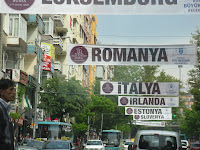
The one above shows the banner for the European Museum Forum. Bursa municipality went to great lengths to make us very welcome...

...including - rather ominously - getting us followed by an ambulance throughout the course of our stay. A Red Crescent, rather than a Red Cross, ambulance, naturally.

The Council of Europe Prize went to the Zeeuws Museum in Middelburg in the Netherlands. Housed in a 12th century abbey, over its seven year closure it developed a new concept for display of its encyclopaedic collections. This involves using artists thinkers and designers to recontextualise collections in a way that makes them relevant to contemporary audiences. In a wonderfully Dutch way, Christie Arends described the museum's mission as "creating future traditions". This is a museum I would truly like to work with - Christie told me that the process of developing exhibitions in this way is like 'experimenting across genres'. From my own experience, I know it can stretch the design and content development process and produces great results when effectively managed. I think many museums could do more of this, balancing their intellectual rigour with a more imaginative approach that truly pushes the boundaries of what museums are actually for. I hope to visit Christie and Zeeuws soon. (information on their Fringe Project- the radical 'makeover' of the museum at http://www.zeeuwsmuseum.nl/script/P_nieuws_detail.asp?ID=54578)
The Micheletti Award for best museum in the technical, technological and industrial sciences was given to the Norwegian Museum of the Jaerben Region, which explores on two sites - a science farm and a science factory - the connections between land and human intervention, in a profoundly agricultural area of Scandinavia. Topical subject matter - linking food production and its processing - along with the aim of increasing social awareness also gained this museum recognition also as Norwegian Museum of the Year.
Three special commendations went to:
Istanbul Modern (Museum of Art) which made an excellent case for the difficulties of launching an independent museum in a country more concerned with its Ottoman and Byzantine heritage than with modernity. A brave and very successful operation - I wish it all the best.
The Museum of Life Stories, in Switzerland - which I talked about in an earlier blog.
The Archaeological Centre of Almoina in Valencia - a museum submerged under the city's main square thanks to a 400m2 glass panel covered by 5 cm of water. The Centre, designed by Spanish company Lunatus (some impressive audiovisual appears on their website http://www.lunatus.com/Highlights/en/Inauguracion-L-Almoina.html) presents the overlapping 5 cities of Valencia. This seems a slick, technically savvy presentation of over 20 years of archaeological digs.
And the (ultimate) winner is...
The Salzburg Museum Neue Residenz is European Museum of the Year 2009. Congratulations to Peter, Esra and Erich and all their team back home! Housed in a stupendous listed building, this is a city museum at its grandest, blending contemporary interventions with historic environments. The museum trail is a provocative dialogue with personalities past and present, and the judges commented specifically on the ground breaking children's trail - the words send a shiver down my spine, but I look forward to exploring it personally. It includes dedicated secret entrances, nooks and crannies for children, which is a wonderful way of allowing for contemporaneous perusal by adults and children, while not imposing pace on either group. A new kind of intergenerational learning? Organised around the theme "Salzburg Myth" the displays on the second floor reveal the connections between the Romantic myths surrounding this beautiful city and their contemporary incarnation in the marketing of Salzburg as tourist destination, Festival City. This is an interesting take on the historical/curatorial view of any city history - and one that maybe Ljubljana City Museum also attempts to grapple with, but with less clarity of message. I am thinking this might be an opportunity to carry out an exercise in peer review between the two. (The website is duly informative and contains some interesting images of the exhibition spaces http://www.salzburgmuseum.at/173.html.)
